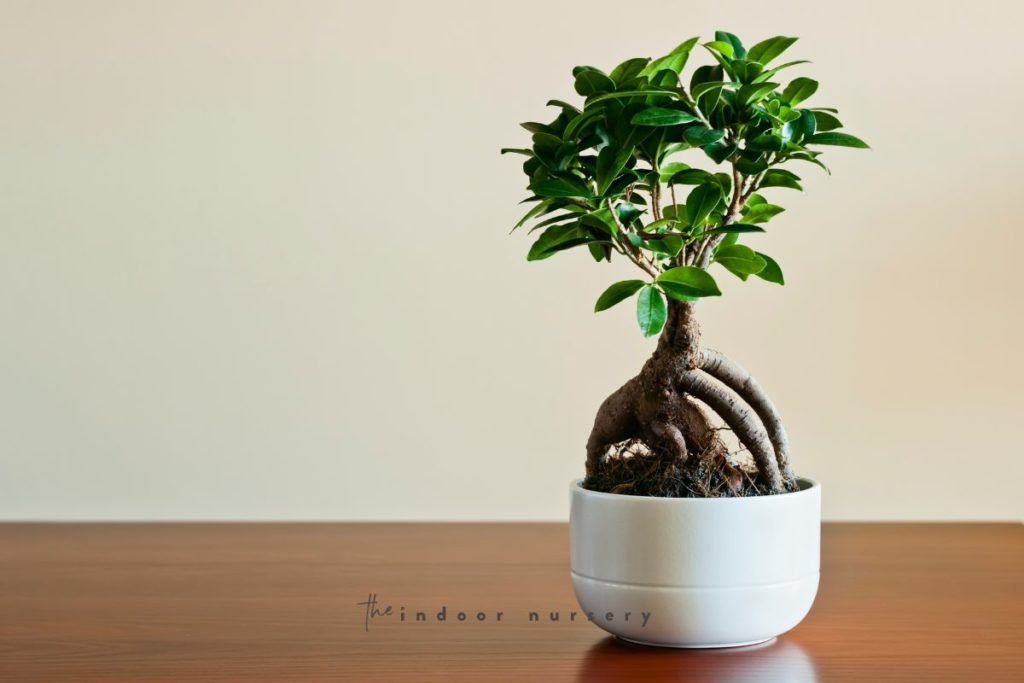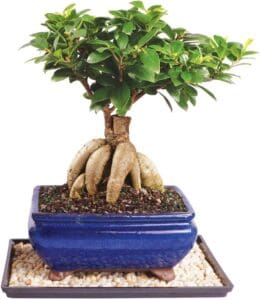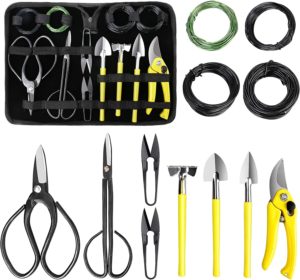The ficus species is resilient and adaptable, making it a popular choice for an indoor bonsai tree.
Ficus bonsai trees are quite tolerant of common beginner mistakes in growing bonsai, such as over watering and low light conditions.
Besides the fact that ficus bonsai care is easy and straight forward, ficus trees are also loved for their fascinating appearance of aerial roots and dark-colored small leaves. With enough time, you too will be amazed by its the unique appearance of surface roots.
You may notice some aerial banyan roots developing and hanging down from the plant’s lower branches.
If you’re taking the leap with a ficus bonsai tree, then, I’ll go over everything you need to keep it happy year round.
light and location
The ficus is not very particular with lighting conditions, which means you can grow it indoors or outdoors. For instance, some varieties of this plant can thrive in an area that receives minimal sunlight while other ficus varieties can survive when exposed to the full sun. However, if you wish to place your plant indoors most of the time, you should position it near a window that is facing west or south. You may also use fluorescent bulbs that can supply sufficient amounts of light that your plant needs.
It’s important to note that if you ever change the lighting conditions of your bonsai trees, such as moving an indoor bonsai outdoors, then you’ll need to provide a hardening period. While most ficus species can tolerate bright sunlight, they need to be slowly introduced to the sunlight to get them used to it.
how to keep bonsai leaves small
Basically, ficus bonsai trees respond to low light conditions by producing more chlorophyll and increasing the size of their leaves. You may also notice that trees placed indoors tend to be more leggy than those that are kept outdoors. If you want your tree to produce smaller leaves and maintain its small trunk size, then you should increase the level of light it receives each day.
key takeaways
- Ficus trees can tolerate both lots of sunlight and low sunlight conditions
- If placed indoors, then put your ficus bonsai in a bright location, like near a window for easy indirect sunlight
- Give your bonsai plants time to “harden” if you’re changing the lighting conditions drastically
- If you want smaller leaves, then put your bonsai tree in a bright location

watering and fertilizing
Ficus varieties such as the neriifolia and salicifolia are not difficult to grow because of their simple watering requirements. Beginners who wish to get started into bonsai gardening may grow these species, since there is little risk of killing the tree by overwatering or underwatering it. Water generously whenever the soil becomes slightly dry, making sure that the root system is never sitting in water to avoid root rot.
Use a spray bottle to mist the bonsai tree every few days. You could also use a plant humidifier to keep the humidity levels in your home consistent for your plants. Many bonsai enthusiasts like to put the bonsai trees in a humidity tray for a traditional way to maintain humidity levels.
As for feeding the tree, you may use a half-strength liquid fertilizer every 2 to 4 weeks. The best time to apply fertilizer is after you have watered it, and make sure you avoid applying any fertilizer when you notice that the tree is already weak.
key takeaways
- Water your ficus bonsai regularly, allowing the soil to become slightly dry in between watering
- Maintain humidity levels with a humidity tray, spray bottle or mister, or plant humidifier
- Fertilize with liquid fertilizer according to manufacturer instructions

pruning and wiring
Regular pruning will help keep the leaf size small and maintain the shape of the bonsai tree. If you want larger branches and a trunk, then allow your ficus bonsai tree to grow for a couple of years before beginning regular pruning. Cover any large wounds with cut paste. New shoots will grow out of the old wood near the wounds, giving you the bushy look that ficus species are known and loved for.
Younger and smaller branches are easy to do but you need to remove the wiring as the plant grows, since it will indeed grow quickly. Stronger, larger branches that are already established can generally handle guy wires left on them for longer periods.
key takeaways
- Regular pruning will help keep the leaf size small and maintain the shape of the bonsai tree
- Check your wiring regularly on young plants to make sure it’s not cutting into the branches as the plant grows
repotting
The ficus tree is known for its vigorous growth, which means that its roots grow quite rapidly. To prevent the plant from becoming pot-bound, try repotting into a new container whenever you notice the root system pushing up out of the bonsai pot.
The ideal time to repot and prune the roots is every year, as this can help maintain the size and shape of your bonsai tree (along with regular pruning year round). As for the soil, the tree can thrive in basic bonsai soil with good aeration and excellent drainage.

common issues with ficus plants
The ficus may drop its leaves because of exposure to stress. However, its leaves should regrow quickly when the tree is moved to a better location. Leaf drop may also occur due to overwatering or when its roots are very dry.
Fig trees are generally pretty resistant to pests, but can be susceptible during dry and cooler seasons, such as in winter. In this case, they usually attract scale and spider mites.
You can use a homemade neem oil spray or other insecticides to help remove anything from the leaves. Some essential oils can treat spider mites in soil. Just keep in mind that the immune system will be weakened due to the pests and the treatment, so you’ll need to be extra gentle with your bonsai plant for a few weeks to months.
learn more about bonsai plants
- How to keep bonsai leaves small
- How long do bonsai trees live? Longer than you.
- How to care for your Japanese black pine bonsai
- How to grow aqua bonsai (water bonsai)
- How to care for a Red Maple bonsai tree
- Pomegranate bonsai tree care guide for beginners
- 15 bonsai styles and shapes that will inspire you
- Bonsai palm tree care: How to care for palm tree bonsais






